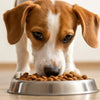What Can I Feed My Dog Other Than Kibble? A Comprehensive Guide to Alternative Dog Foods
- Houndsy
Table of Contents
- Introduction
- Understanding Your Dog's Nutritional Needs
- Safe Alternatives to Kibble
- Foods to Avoid
- How to Prepare Alternative Meals
- Transitioning Back to Kibble
- Conclusion
Introduction
Imagine it's dinner time, and you've just realized that your dog’s kibble bag is empty. Panic sets in as you wonder: What can I feed my dog other than kibble? You’re not alone—many pet owners face this dilemma, whether due to a last-minute shopping oversight or running out of their dog's favorite food unexpectedly.
In fact, recent surveys indicate that approximately 30% of dog owners have found themselves in this situation at least once, often leading to a scramble for suitable alternatives from their pantries. The good news is that there are numerous safe and nutritious options available at home that can serve as temporary substitutes. This blog post aims to provide you with a comprehensive overview of what you can feed your dog when you run out of kibble, ensuring they remain happy and healthy while you restock their regular food.
By the end of this article, you will understand various safe alternatives to kibble, the nutritional benefits of these options, and how to prepare them properly. We’ll delve into the types of food that are dog-friendly and those that should always be avoided. Additionally, we’ll explore how to transition back to their regular diet after using these alternatives.
So, whether you're a seasoned pet parent or a new dog owner, let's reflect on your current feeding routine and consider how we can enhance your dog's diet beyond traditional kibble.
Understanding Your Dog's Nutritional Needs
Before we dive into alternative food options, it’s essential to understand your dog’s basic nutritional requirements. Dogs are omnivores, which means they can thrive on a variety of foods. However, a balanced diet is crucial for their overall health. Here are the key nutrients dogs require:
- Proteins: Essential for growth and repair of tissues.
- Fats: Provide energy and support cell function.
- Carbohydrates: A source of energy and help with digestive health.
- Vitamins and Minerals: Vital for metabolic processes and overall health.
When considering what to feed your dog other than kibble, it’s important to ensure that any alternative food provides these essential nutrients.
Safe Alternatives to Kibble
When you find yourself out of dog food, there are several human foods that can serve as temporary alternatives. Here’s a detailed list of dog-friendly options:
1. Cooked Lean Meats
Lean meats like chicken, turkey, and beef can be excellent sources of protein. Ensure that they are cooked without any seasoning, fats, or sauces.
- Recommendation: Mix cooked chicken with some plain rice for a comforting dish.
2. Eggs
Cooked eggs are a nutrient-dense option rich in protein and essential fatty acids. They are easy to prepare and generally well-tolerated by dogs.
- How to Serve: Scrambled or hard-boiled without any added salt or butter.
3. Fruits
Many fruits are safe for dogs and can even provide health benefits. Here are some options:
- Apples: Remove the seeds and core; apples are high in vitamins A and C.
- Blueberries: Packed with antioxidants and low in calories.
- Bananas: A sweet treat that provides potassium, but should be given in moderation due to sugar content.
4. Vegetables
Vegetables can be a great source of fiber and vitamins. Safe options include:
- Carrots: Raw or cooked, they can help clean your dog’s teeth and are low in calories.
- Green Beans: These are low in calories and high in fiber.
- Pumpkin: Plain, cooked pumpkin can aid digestion and is low in calories.
5. Rice and Pasta
Plain, cooked rice and pasta can help soothe a dog's stomach and serve as a carbohydrate source.
- Recommendation: Combine with lean meat for a balanced meal.
6. Cottage Cheese and Yogurt
Plain, low-fat dairy products can be a good source of protein and probiotics, but watch for lactose intolerance.
- How to Introduce: Start with small amounts to see how your dog reacts.
7. Peanut Butter
Unsalted and xylitol-free peanut butter can be a delightful treat for dogs. It offers healthy fats and protein.
- Serving Suggestion: Stuff it into a toy for an engaging activity.
Foods to Avoid
While many human foods are safe for dogs, some can be harmful or even toxic. It’s crucial to avoid the following:
- Chocolate: Highly toxic and can cause serious health issues.
- Grapes and Raisins: Can lead to kidney failure.
- Onions and Garlic: Toxic to dogs and can cause anemia.
- Avocado: Contains persin, which can be harmful to dogs.
- Alcohol: Even small amounts can be dangerous.
Always familiarize yourself with which foods are safe and which are not, as even small amounts of toxic foods can have serious consequences.
How to Prepare Alternative Meals
When preparing alternative meals for your dog, follow these guidelines:
- Balance is Key: Aim for a mix of protein, carbohydrates, and vegetables. A good ratio to follow is two parts protein to one part grain and vegetables.
- Keep It Simple: Use plain, unseasoned ingredients to avoid any harmful additives or flavors.
- Avoid Fatty Foods: High-fat foods can upset your dog’s stomach and lead to pancreatitis.
Sample Meal Combinations
Here are a few simple meal combinations you can try:
- Chicken and Rice: Boil chicken breast and mix it with plain white rice.
- Beef and Vegetables: Cook ground beef with carrots and peas.
- Egg and Spinach: Scramble eggs and mix with steamed spinach.
Transitioning Back to Kibble
Once you’ve used alternative foods to feed your dog, it’s important to transition them back to their regular kibble gradually. Here’s how to do it:
- Start Slow: Begin by mixing a small amount of kibble with the alternative food.
- Increase Gradually: Over a few days, gradually increase the proportion of kibble while decreasing the alternative food.
- Monitor for Reactions: Watch for any signs of digestive upset, and adjust the transition according to your dog's comfort.
Conclusion
Feeding your dog when you're out of kibble doesn’t have to be a stressful experience. By having a variety of safe human foods on hand, you can ensure that your furry friend still receives a nutritious meal. Remember, these temporary alternatives are not meant to replace a balanced diet long-term. They serve as a practical solution until you can restock your dog's preferred food.
If you’re looking for an innovative way to enhance your dog’s feeding experience, consider our Houndsy Kibble Dispenser. It not only makes portion control easy but also keeps your dog’s food fresh and accessible in a stylish design that complements your home decor. You can explore the Houndsy Kibble Dispenser here.
FAQ
1. Can I feed my dog human food every day?
- While some human foods are safe for dogs, they should only make up a small part of their diet. Always prioritize a balanced dog food.
2. What are the signs of food intolerance in dogs?
- Symptoms can include vomiting, diarrhea, itchy skin, or excessive gas. If your dog exhibits these signs, consult your veterinarian.
3. Is it safe to mix different types of dog food?
- Generally, it’s safe to mix different types of dog food, but make sure they are nutritionally balanced.
4. How can I ensure my dog gets a complete diet?
- Consult your veterinarian for guidance on what commercial dog food brands or homemade diets can provide a balanced nutrition for your dog.
By being prepared and informed, we can enhance our dogs' feeding experiences, ensuring they remain healthy and satisfied, whether it’s with kibble or a temporary alternative.












